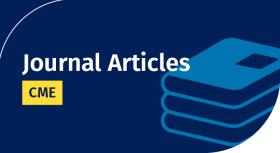
Diagnosis of Hypersensitivity Pneumonitis in Adults, 2020 Clinical Practice Guideline: Summary for Clinicians
Hypersensitivity pneumonitis (HP) is characterized by inflammatory and/or fibrotic destruction of the lung parenchyma and small airways mediated by an immune response to an inhaled antigen in a susceptible individual. Historic categories of acute, subacute, or chronic HP without precise radiographic, histopathologic, and prognostic correlates have made diagnosis and treatment challenging.
An ad hoc, multidisciplinary committee of international experts from North America, Japan, Latin America, Europe, and Australia, appointed by the American Thoracic Society, Japanese Respiratory Society, and the Asociación Latinoamericana del Tórax, consolidated available evidence informing clinical features of HP, publishing new diagnostic criteria and graded recommendations for the diagnostic approach. This summary is intended to provide the practicing clinician with key points from the guideline.
This guideline complements the 2018 American Thoracic Society/European Respiratory Society/Japanese Respiratory Society/Asociación Latinoamericana del Tórax guideline on the diagnosis of idiopathic pulmonary fibrosis (IPF) and focuses on the diagnostic approach to the adult patient with interstitial lung disease (ILD) in whom the history suggests a potential culprit exposure. Guidelines have different implications for patients, clinicians, and policymakers. Clinicians should always consider unique patient characteristics and preferences when evaluating patients with ILD.
Target Audience
Pulmonologists, critical care specialists, translational researchers, and clinicians
Learning Objectives
At the conclusion of this activity, learners should be able to:
- Differentiate between radiographic features of nonfibrotic and fibrotic hypersensitivity pneumonitis (HP).
- Apply the proposed diagnostic algorithm for the evaluation of suspected HP.
- Discuss the histopathologic findings which would distinguish HP from an alternative diagnosis.
Accreditation Statement
The American Thoracic Society is accredited by the Accreditation Council for Continuing Medical Education to provide continuing medical education for physicians.
Disclosure Declaration
Article Authorship Disclosures (as submitted to the ATS prior to article publication date)
Megan A. Koster, M.D., Pharm.D. (Mount Auburn Hospital, Cambridge, MA, USA) reported no relevant financial relationships.
Carey C. Thomson, M.D., M.P.H. (Mount Auburn Hospital, Cambridge, MA, USA) reported no relevant financial relationships.
Bridget F. Collins, M.D. (University of Washington Medical Center, Seattle, WA, USA) reported serving on an advisory board for Boehringer Ingelheim
Alex R. Jenkins, B.S.(Hons), M.Phil., Ph.D. (University of Nottingham, Nottingham, United Kingdom) reported no relevant financial relationships.
Joseph K. Ruminjo, M.D. (American Thoracic Society, New York, NY, USA) reported no relevant financial relationships.
Ganesh Raghu, M.D. (University of Washington Medical Center, Seattle, WA, USA) reported serving as a consultant for IPF- and PF-related studies for Boehringer Ingelheim and Roche-Genentech.
Off-Label Usage Disclosure
None
Disclosures of AnnalsATS CME Planners
The Annals of the American Thoracic Society (AnnalsATS) original research, commentaries, reviews, and educational content of interest to clinicians and clinical investigators in pediatric and adult pulmonary and sleep medicine and medical critical care. The scope of the journal encompasses content that is applicable to clinical practice, the formative and continuing education of clinical specialists, and the advancement of public health.
The publication of articles that meet these goals by itself is only one step in a multi-step process for the translation of evidence-based improvements in are to clinical practice. Testing for CME credit is designed to function as a next step in the process. This is accomplished through a series of questions written by the author(s) to test that readers have the tools needed to translate recommendations for diagnostic and therapeutic clinical care into clinical practice. Members of the AnnalsATS editorial board review these questions and edit these questions for clarity, educational content, and the quality of the evidence supporting the response to the question.
AnnalsATS CME Planners
Alan M. Fein, M.D.
Podcast Editor, AnnalsATS
Dr. Fein reported that he has no financial relationships with ineligible companies.
Constantine Manthous, M.D.
Associate Editor, AnnalsATS
Dr. Manthous reported that he has no financial relationships with ineligible companies.
Gregory A. Schmidt, M.D.
Editorial Board, AnnalsATS
Dr. Schmidt reported payments for writing a textbook on critical care medicine (McGraw-Hill) and for writing contributions for UptoDate.
Instructions to Receive Credit
To receive credit for this journal article:
- Read the journal article. Keep track of how long it takes you to read it.
- Once you open the article, the Post-Test becomes available. After reading the article, answer the post-test questions. You must answer all questions correctly to earn credit. You may take the test as many times as you like.
- Once you pass the Post-Test, the Evaluation becomes available. Answer all the evaluation questions.
- Once you complete the evaluation, select the amount of credit to receive based on the time it took you to read the article.
- You can view, save and print your Certificate by pressing the Certificate button.
- To review the credits you've earned in this system and reprint certificates, go to the My Learning drop-down list. Then select Transcript.
Available Credit
- 1.00 AMA PRA Category 1 Credit(s)™The American Thoracic Society designates this for a maximum of 1.00 AMA PRA Category 1 Credit(s)™. Physicians should claim only the credit commensurate with the extent of their participation in the activity.
- 1.00 Participation

 Facebook
Facebook X
X LinkedIn
LinkedIn Forward
Forward